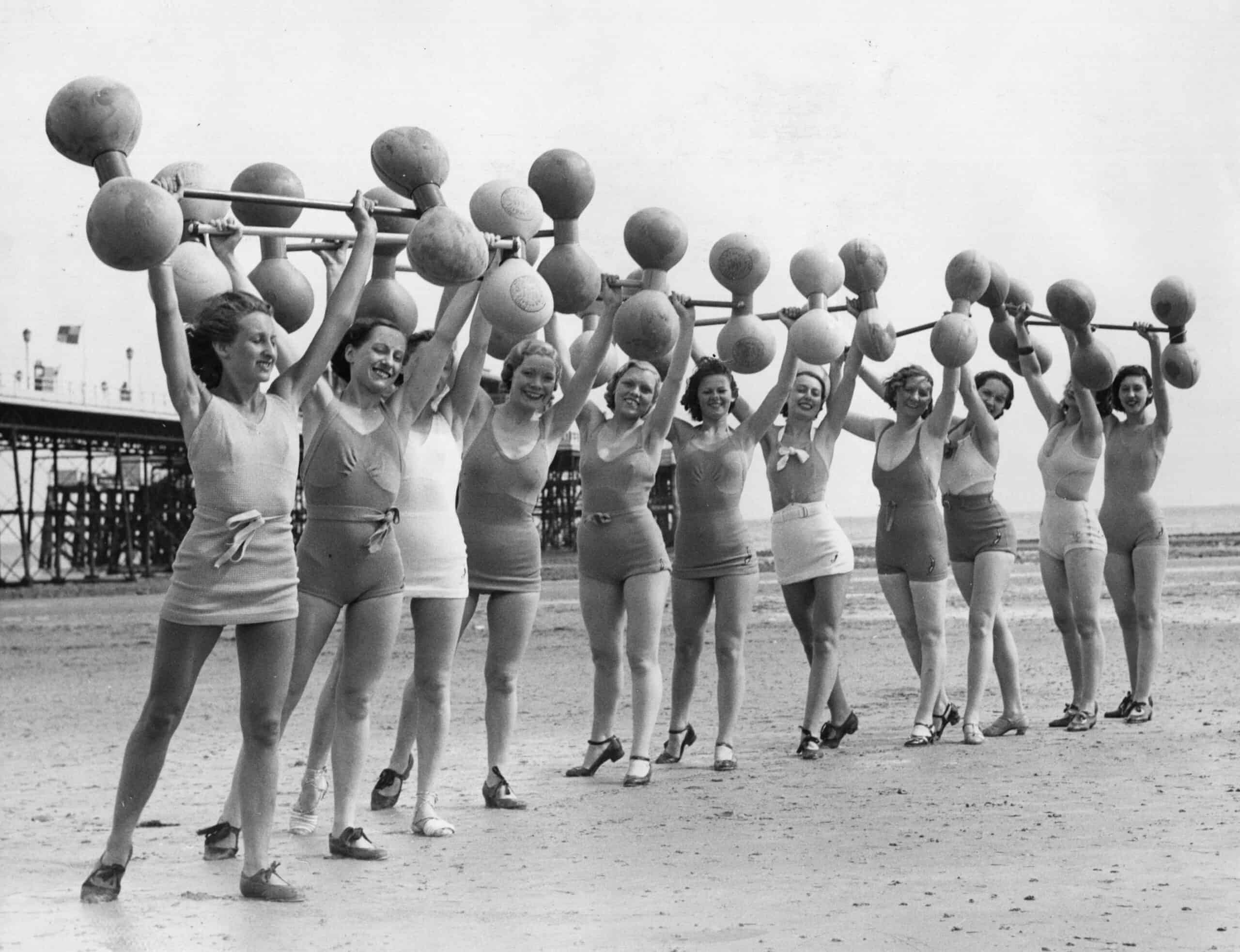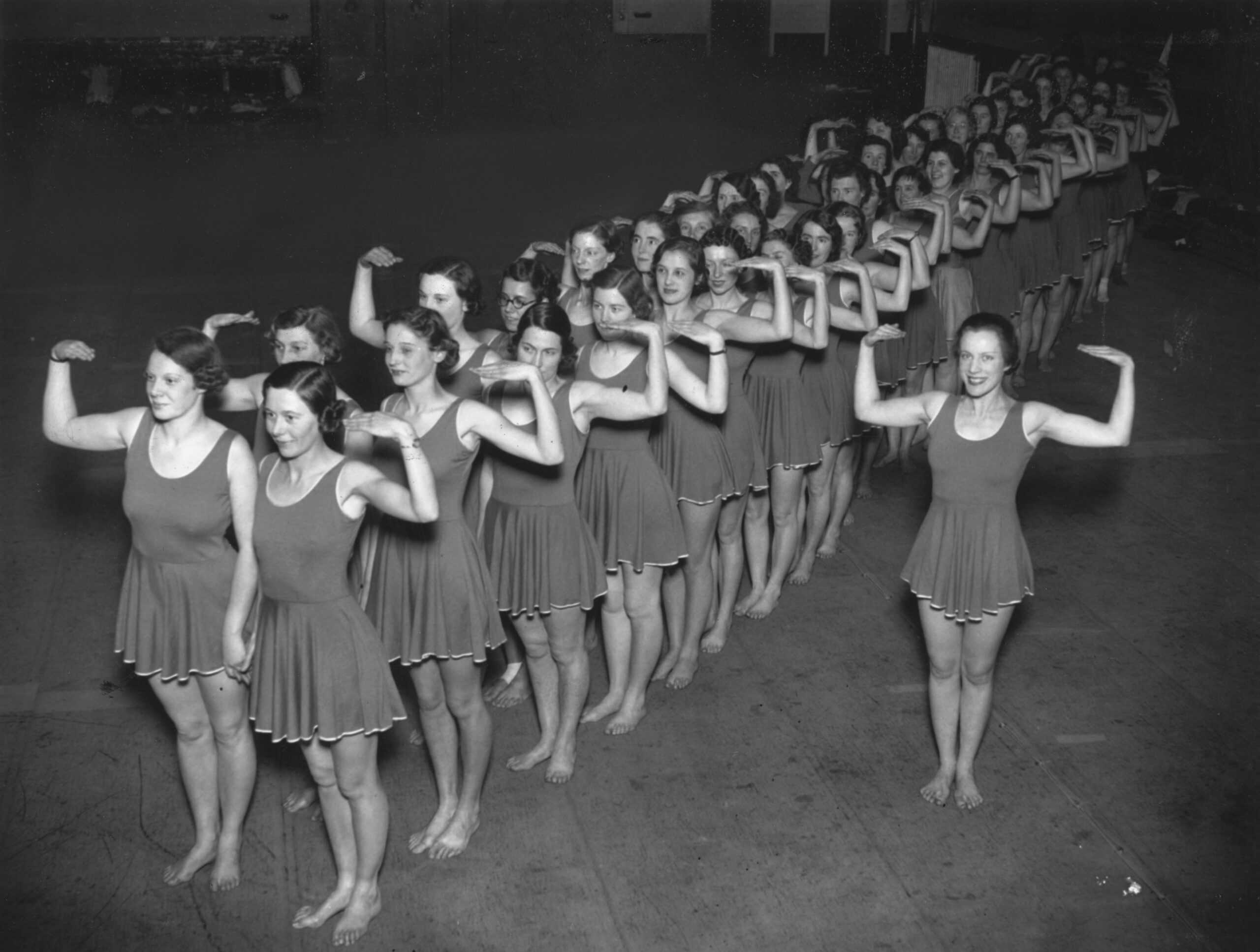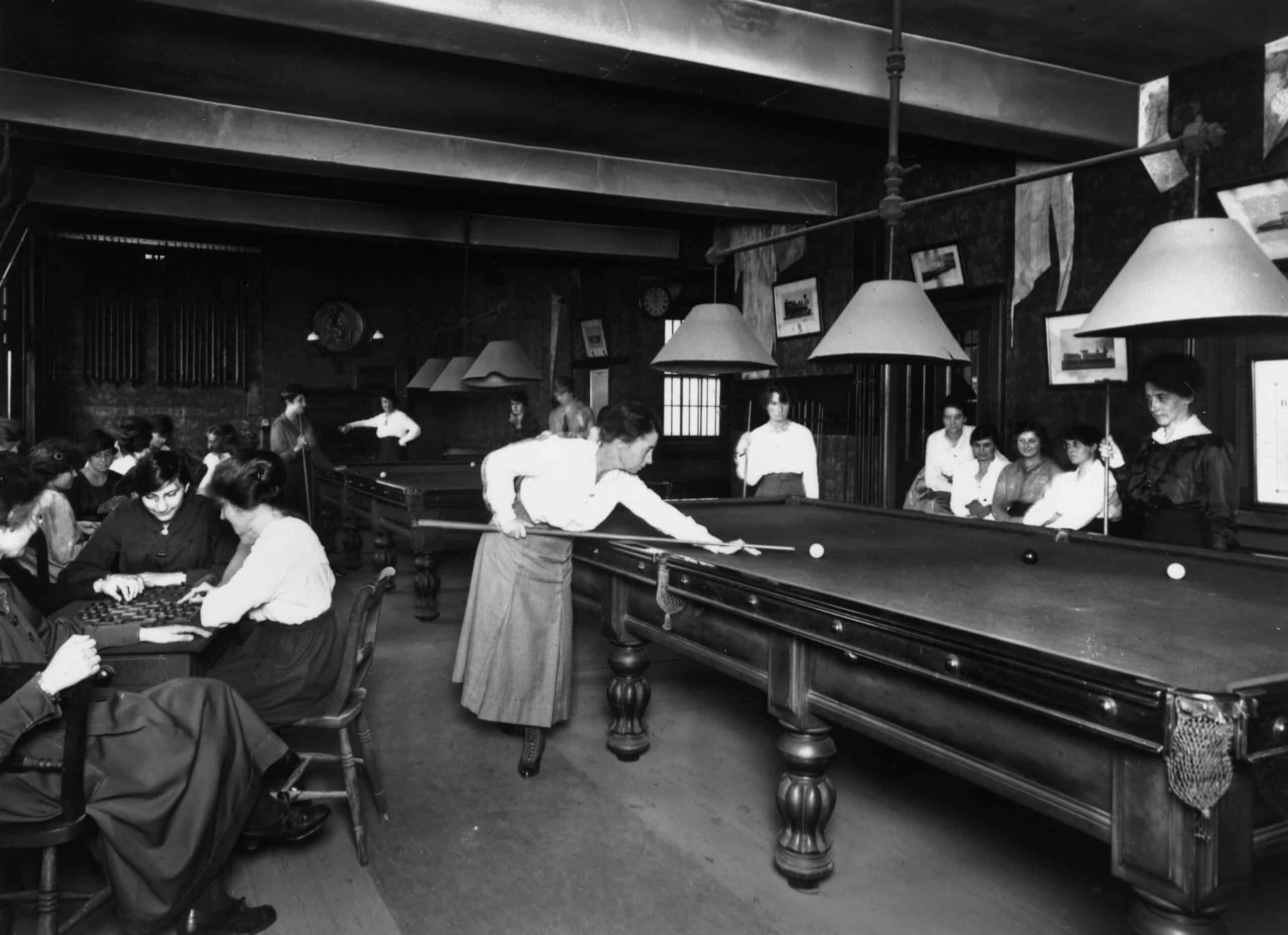Well before modern exercise trends like boot camps and barre classes, women engaged in recreational physical activities and fitness in different ways. Even though sports were usually only for men, women found their own athletic pursuits, from jumping rope to archery. They enjoyed taking part in physical pastimes, even if they weren’t considered traditional women’s activities.
Take a look at some of the most fascinating photos from the early 20th century that showcase innovative activities for the time — and then marvel at just how far women’s fitness and extracurricular activities have evolved. (And since we’re talking about women — check out the greatest women innovators and inventors.)
Cycling
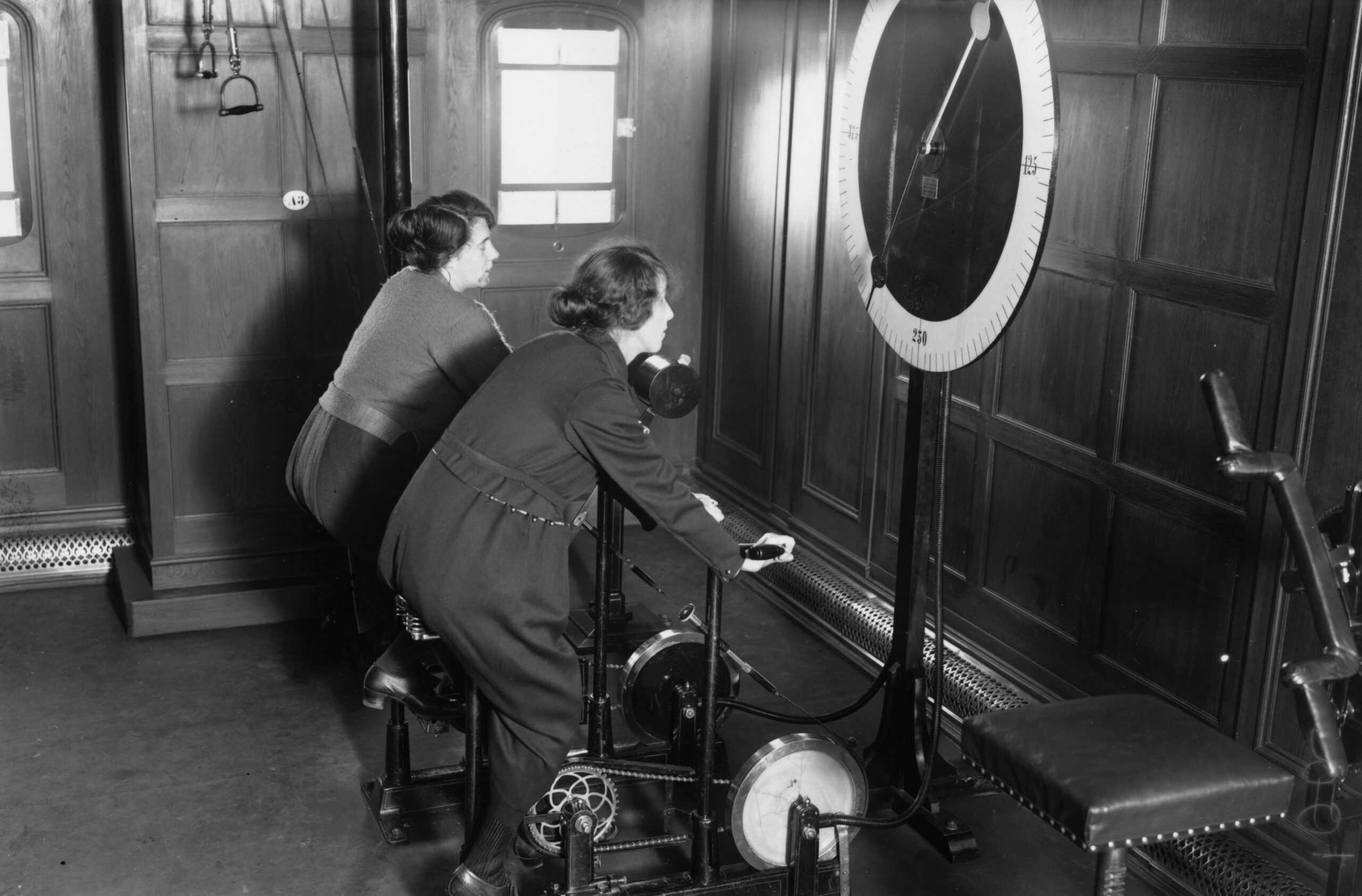
Two women using the cycle machine in the gym on board the Homeric Liner, taken over from the Germans by White Star. (Photo by Topical Press Agency/Getty Images)
Long before there was SpinCycle or Peloton, there were cycling machines like those pictured here, circa 1922, in the gymnasium on the Homeric, a ship owned by White Star (the same company that operated Titanic). Cycling machines were commonly found in the fitness spaces on world-class ocean liners and were considered an activity primarily for the elite.
Rowing
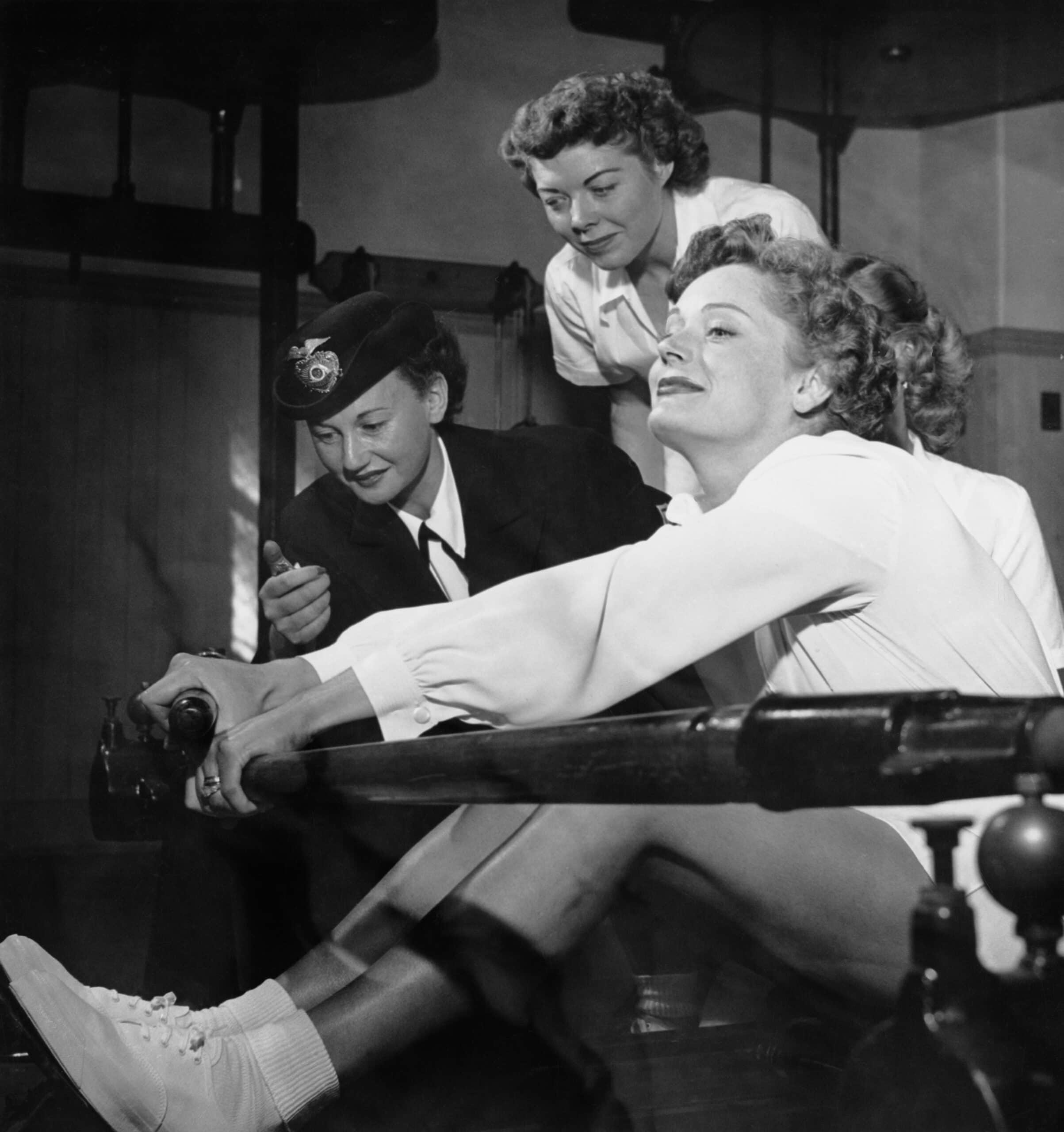
Canadian-born actress Alexis Smith (1921 - 1993) uses a rowing machine, while a police officer times her with a stopwatch, USA, circa 1951. (Photo by Archive Photos/Getty Images)
Actress and singer Alexis Smith is shown here getting in shape on a rowing machine in 1951. Smith was a film star first and closed out her career on stage, where she earned a Tony for her role in Follies. Fun fact: the rowing machine was invented in 1872.
Swim Bars
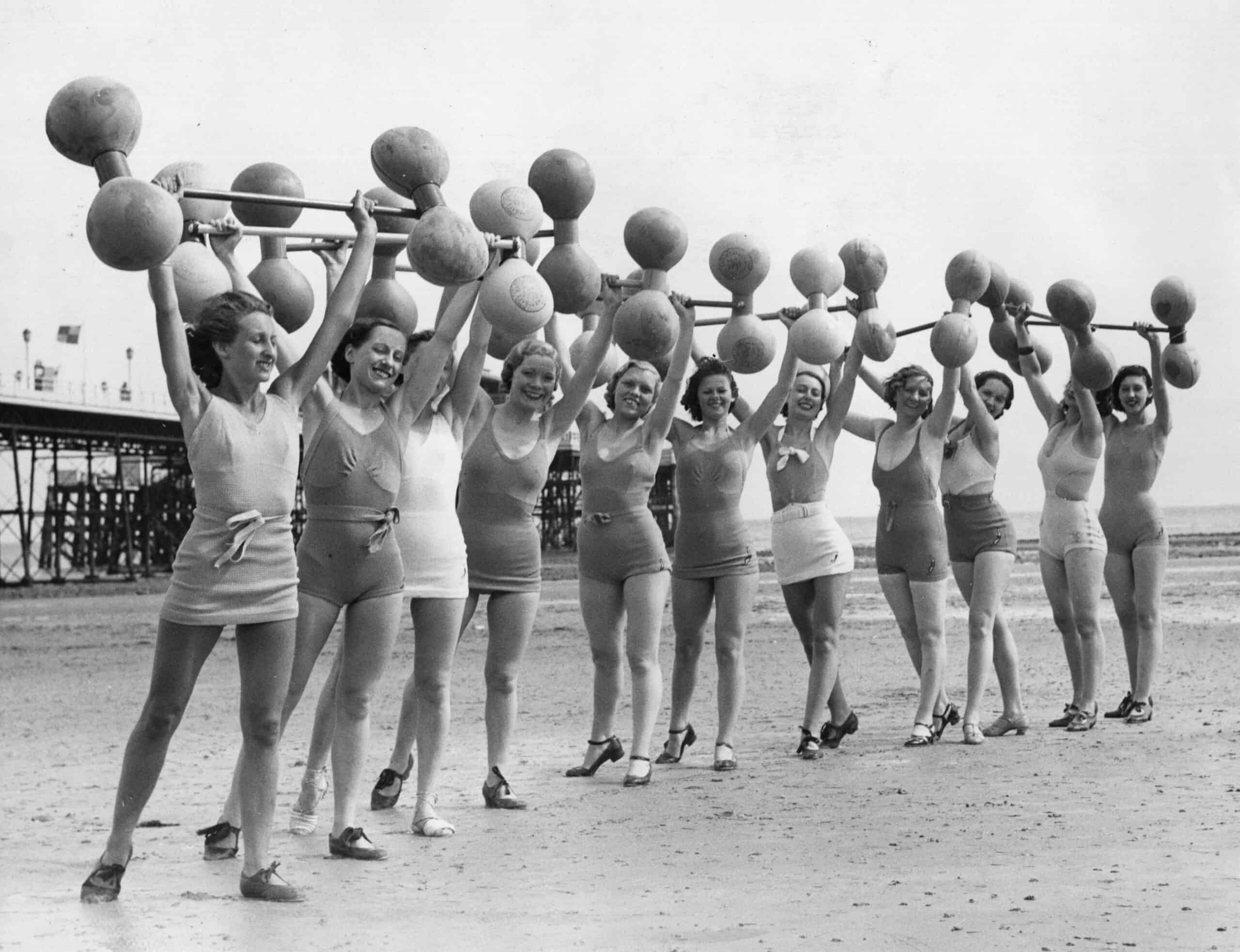
28th June 1935: A group of women exercising on the beach at Worthing using new inflated 'swim bars'. (Photo by William Vanderson/Fox Photos/Getty Images)
Back in the summer of 1935, these gals used a brand-new apparatus known as inflatable swim bars. While this type of swimming fitness device still exists, it’s been fine-tuned with a more sleek design for the modern aquatics enthusiast.
Tennis

French tennis player Suzanne Lenglen (1899 - 1938) in play at the Lawn Tennis Championships at Wimbledon, London, 1st July 1919. She won the Women's Singles title that year. (Photo by Topical Press Agency/Hulton Archive/Getty Images)
Back in 1919, French tennis player Suzanne Lenglen took the women’s singles title at Wimbledon — her first of five in a row. She was a maverick in the sport of women’s tennis as well as the fashions worn in play — her tennis outfit shown here was considered risque at the time, being called “indecent” by reporters.
Lacrosse
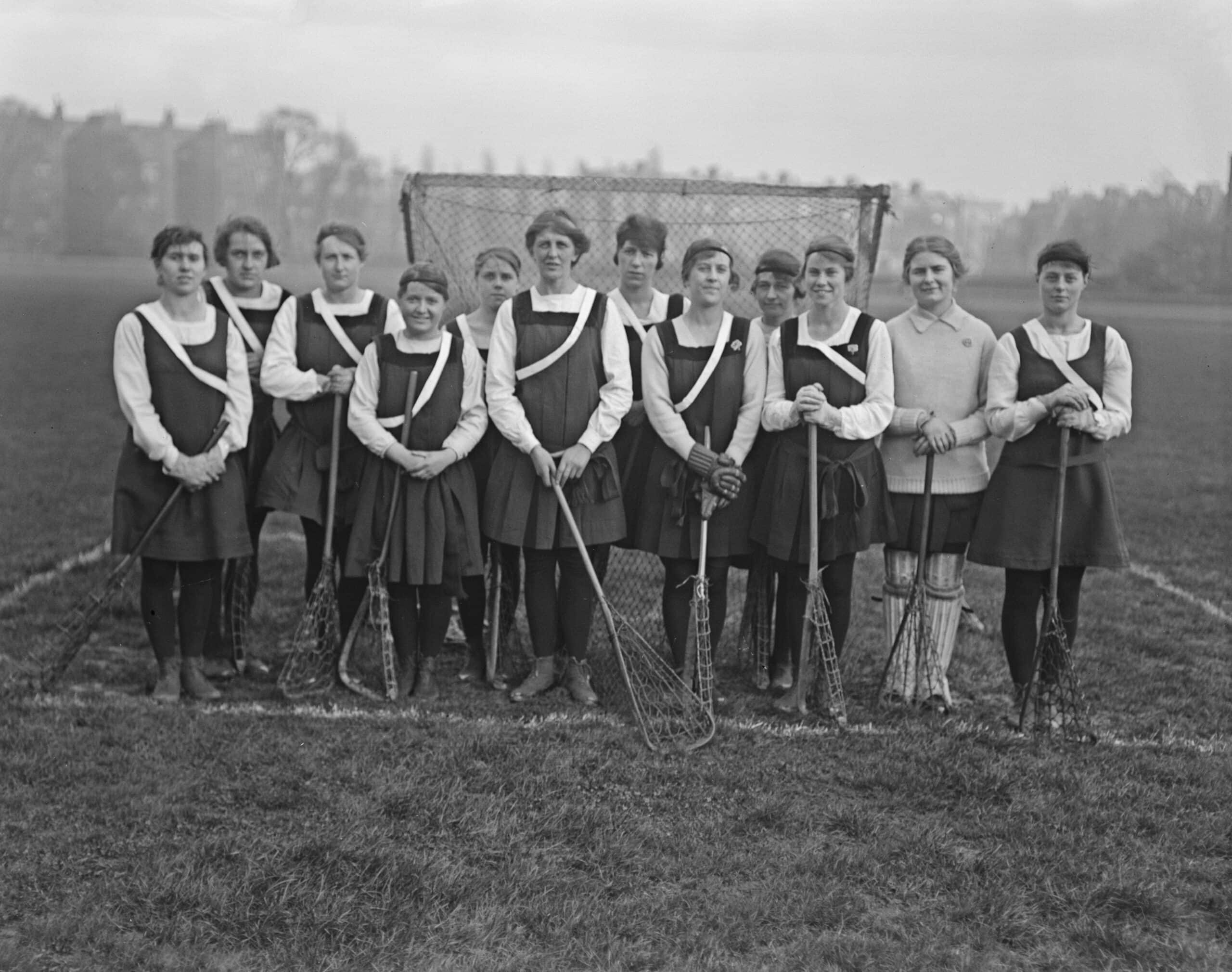
Surrey Ladies lacrosse players pose for a team portrait ahead of the lacrosse game between London Co and Surrey Ladies, England, United Kingdom, 21st February 1920. (Photo by Adams/Topical Press Agency/Hulton Archive/Getty Images)
The Surrey Ladies lacrosse team, pictured here in 1920, wore uniforms that skewed more “masculine.” The trend at that time was for women’s lacrosse uniforms to look more like men’s, thereby elevating the status of the women’s version of the sport from merely recreational to competitive.
Football (Soccer)
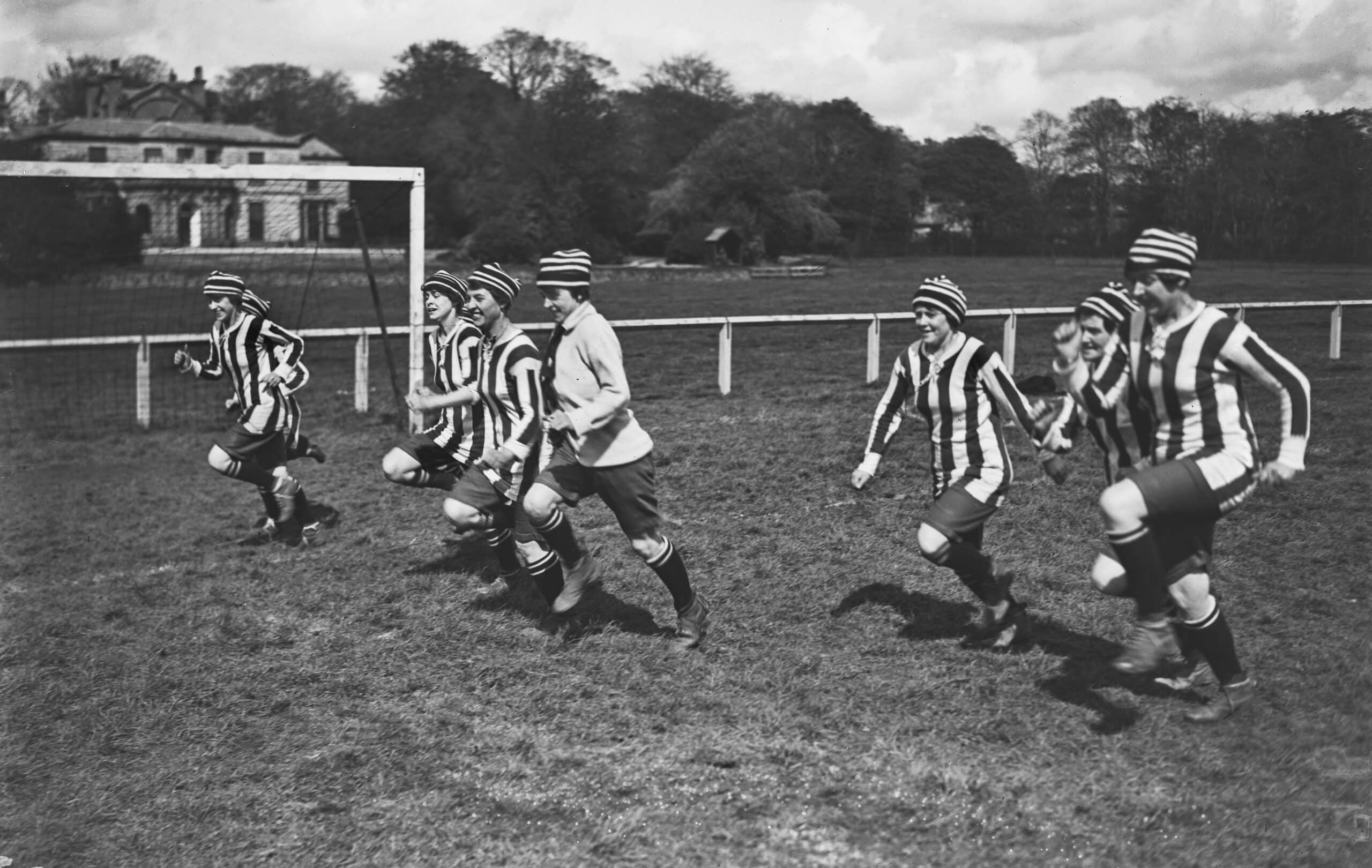
Players of team Dick, Kerr Ladies F.C representing England at a training session before an international match against the French women's soccer team, at Deepdale in Preston, UK, 29th April 1920. (Photo by John Warwick Brooke/Topical Press Agency/Hulton Archive/Getty Images)
The Dick, Kerr Ladies Football Club players (a factory team pictured here in 1920) train in advance of a match. The following year, this club drew such large crowds and raised so much money that the Football Association (FA) and the political establishment took note of the rise in popularity of the women’s sport. With that popularity came power, and as such, the women’s sport was seen as problematic and a threat to the establishment. That’s why women’s football was banned the following year. The FA’s consultative committee stated, upon the decision to ban the sport, “Complaints having been made as to football being played by women, Council felt impelled to express the strong opinion that the game of football is quite unsuitable for females and should not be encouraged.” The ban lasted for 51 years.
Golf
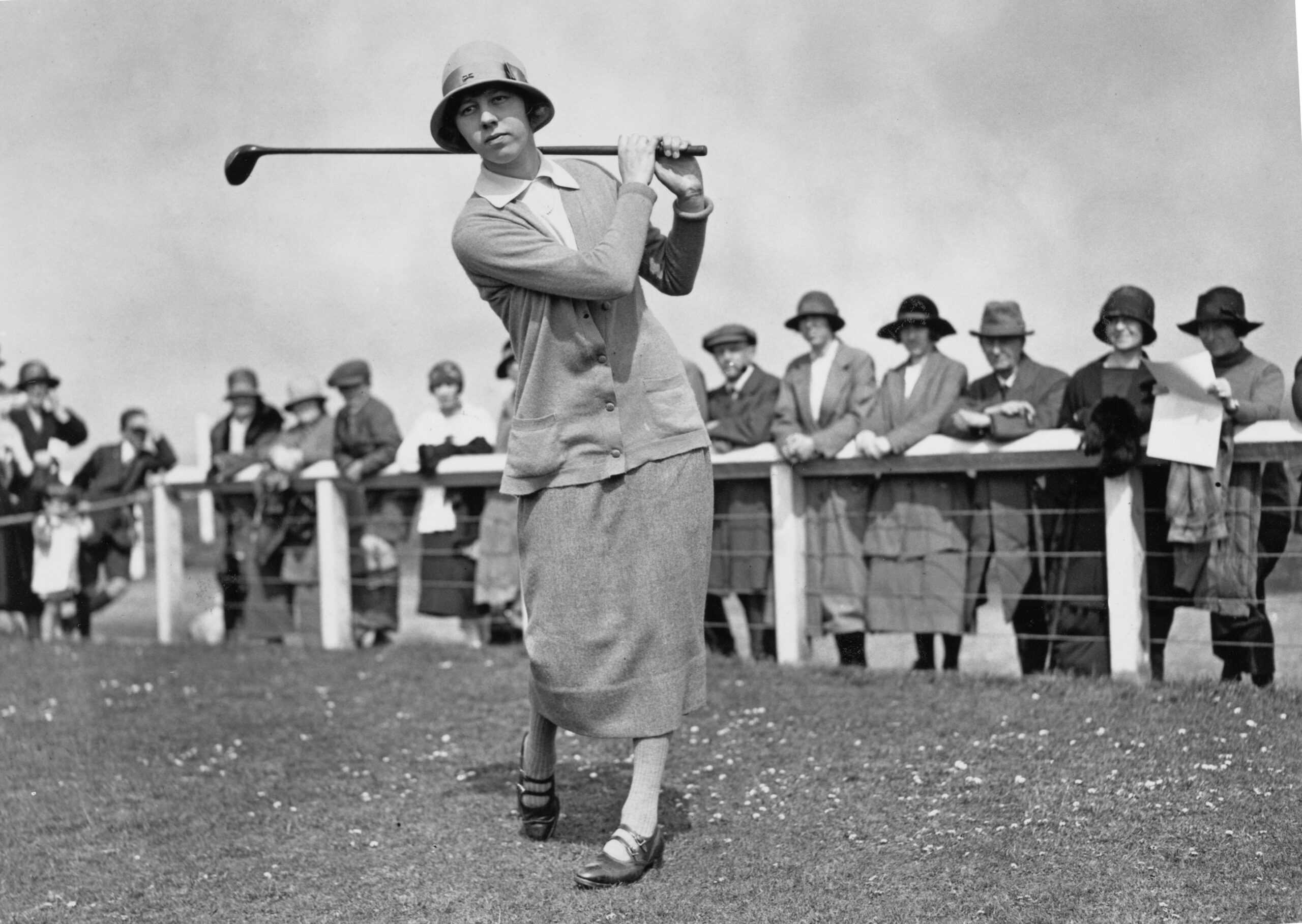
Joyce Wethered, Lady Heathcoat-Amory of Great Britain (1901 - 1997) follows her drive off the tee watched by a group of spectators during the 1925 Womens Amateur Championship golf tournament on 22nd May 1925 at the Royal Troon Golf Club in Troon, South Ayrshire, Scotland, United Kingdom. (Photo by Topical Press Agency/Hulton Archive/Getty Images)
Joyce Wethered, pictured here in 1925, was considered the greatest British women’s golfer of the interwar period — the time between the first and second World Wars. Wethered was a four-time winner of the British Ladies Amateur tournament, and she won the English Ladies’ Amateur Championship five years in a row before retiring from golf in 1930. Note her standard two-piece golf outfit: A straight or pleated skirt and top, worn with socks and rubber-soled shoes, was the modern women’s golf attire at the time.
Keep-Fit
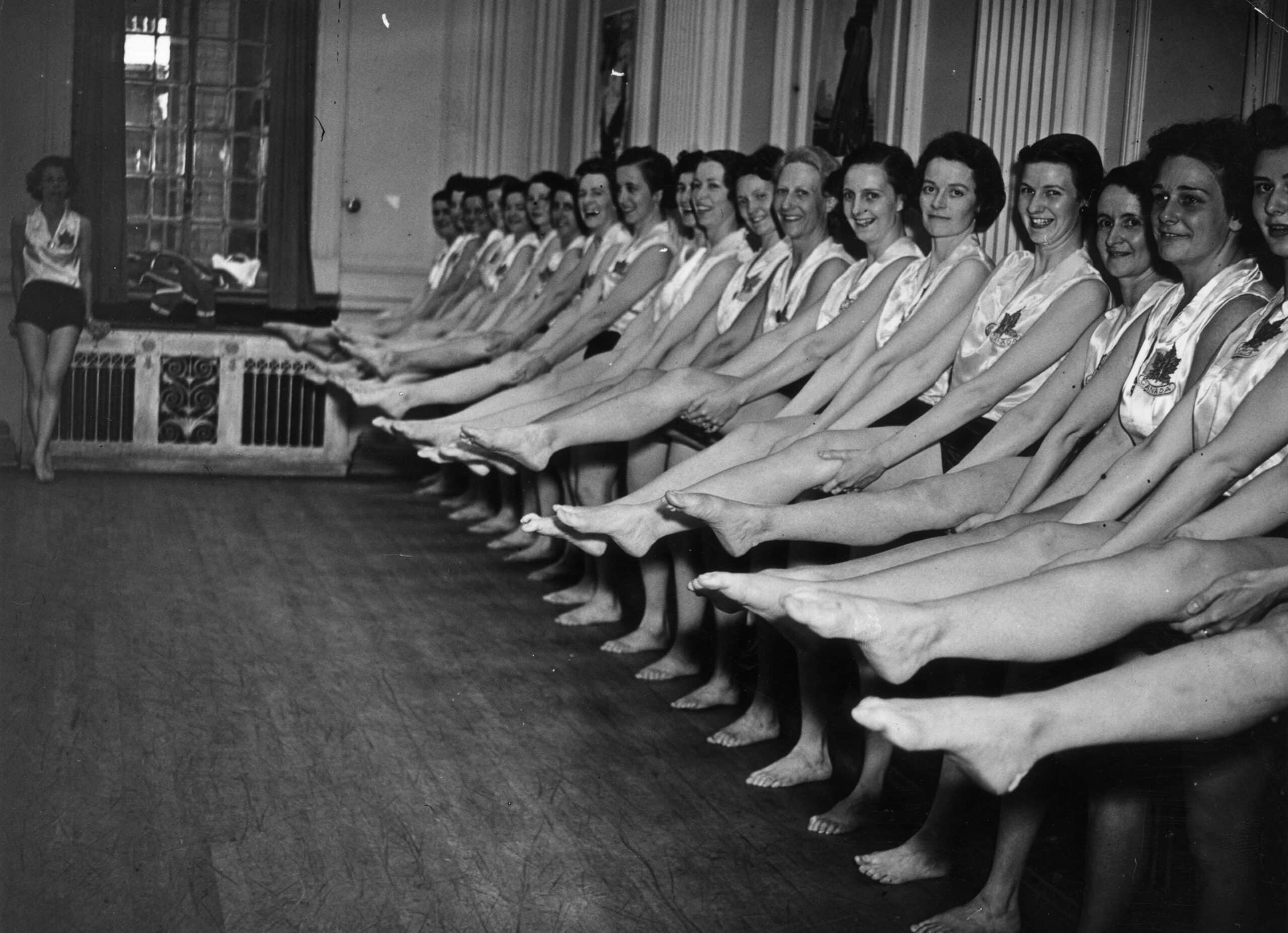
7th June 1937: Women's League of Health & Beauty, rehearsing for Health and Beauty display. (Photo by John F. Stephenson/Topical Press Agency/Getty Images)
Members of the Women’s League of Health & Beauty show off their gams back in 1937. The league was formed by Mary Bagot Stack in 1930. It was called a “keep-fit system,” and its popularity spread throughout the world as interest in women’s physical recreation was on the rise.
Jump Rope
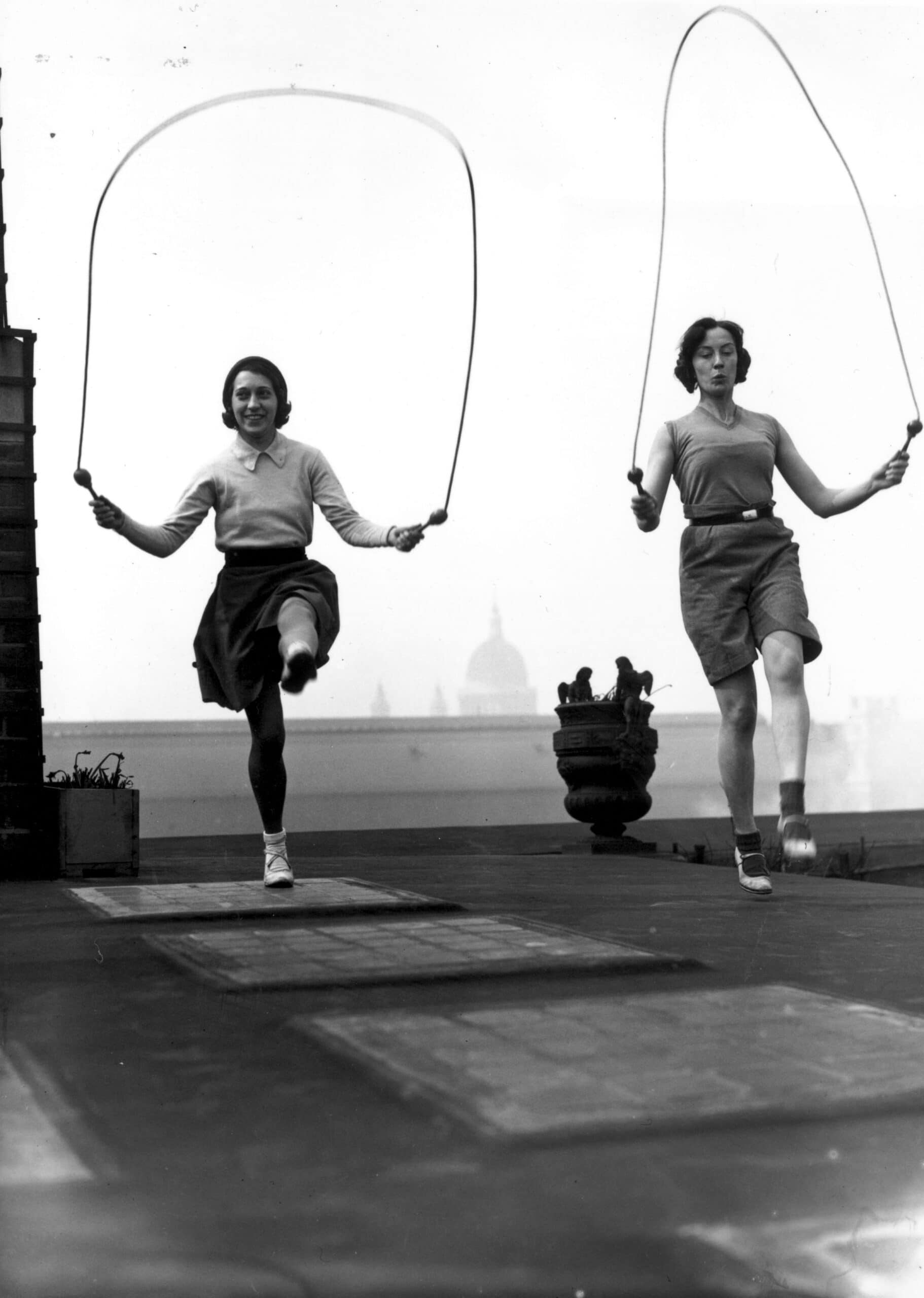
13th April 1932: Two women skipping on a London roof top in the shadow of St Paul's Cathedral. (Photo by Davis/Topical Press Agency/Getty Images)
Jump rope originated in the 1600s and was a popular activity for boys. Girls, on the other hand, were not encouraged to partake as doing so may cause their ankles to show. (GASP!) Here, two women in 1932 throw caution to the wind and skip to their hearts’ content.
Exercise Class
Uniformity was the name of the game in this 1937 group exercise class. Note that no footwear is worn and the skirts are remarkably short.
Pommel Horse
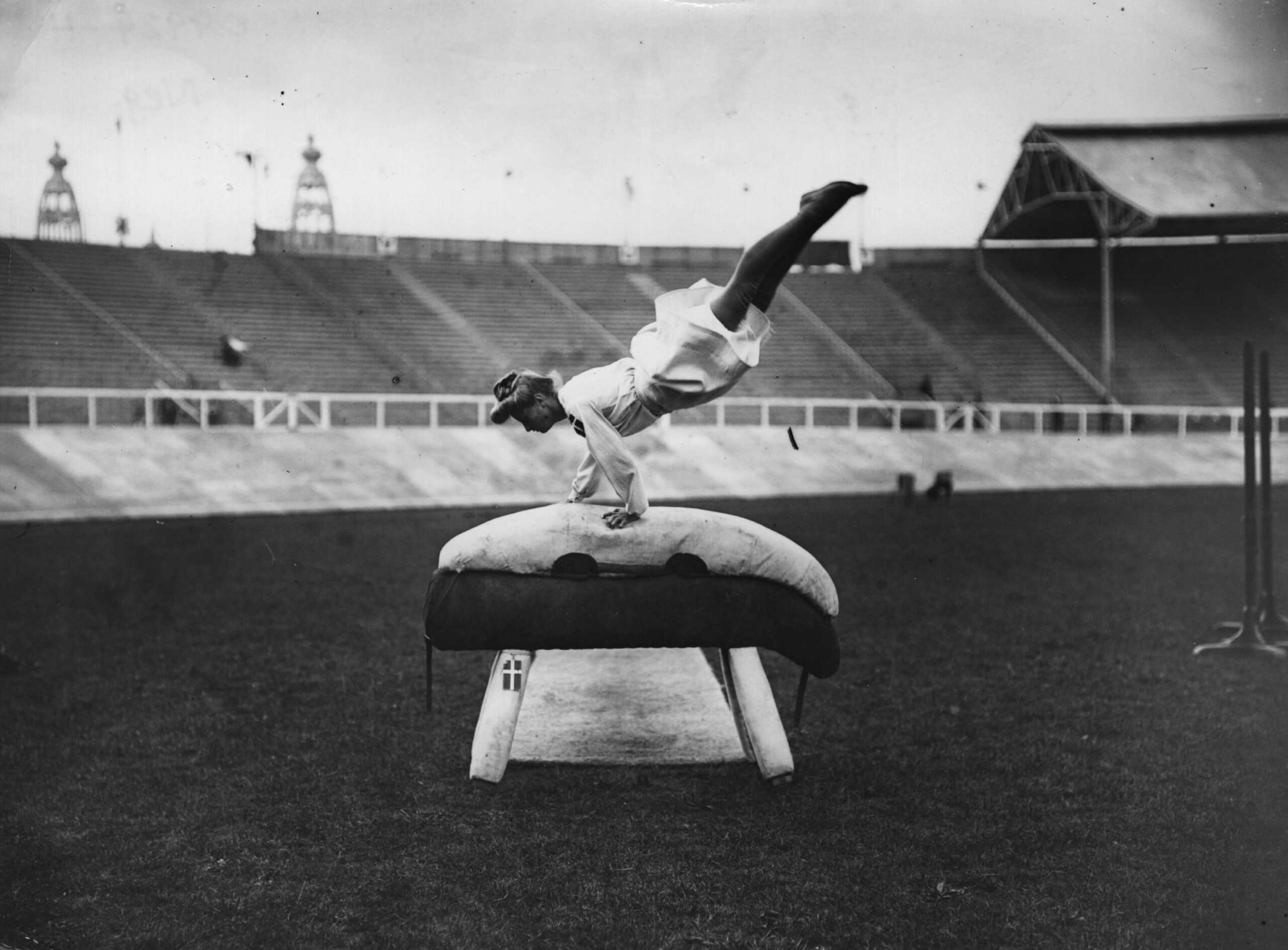
July 1908: A Danish gymnast performing on a gymnastic pommel horse at the 1908 London Olympics. (Photo by Topical Press Agency/Getty Images)
Here, a Danish gymnast performs on the pommel horse (now known as the vault) at the 1908 Summer Olympic Games in London. Women did not compete in gymnastics at the 1908 games; they only performed “gymnastic displays.”
Vibration Machine
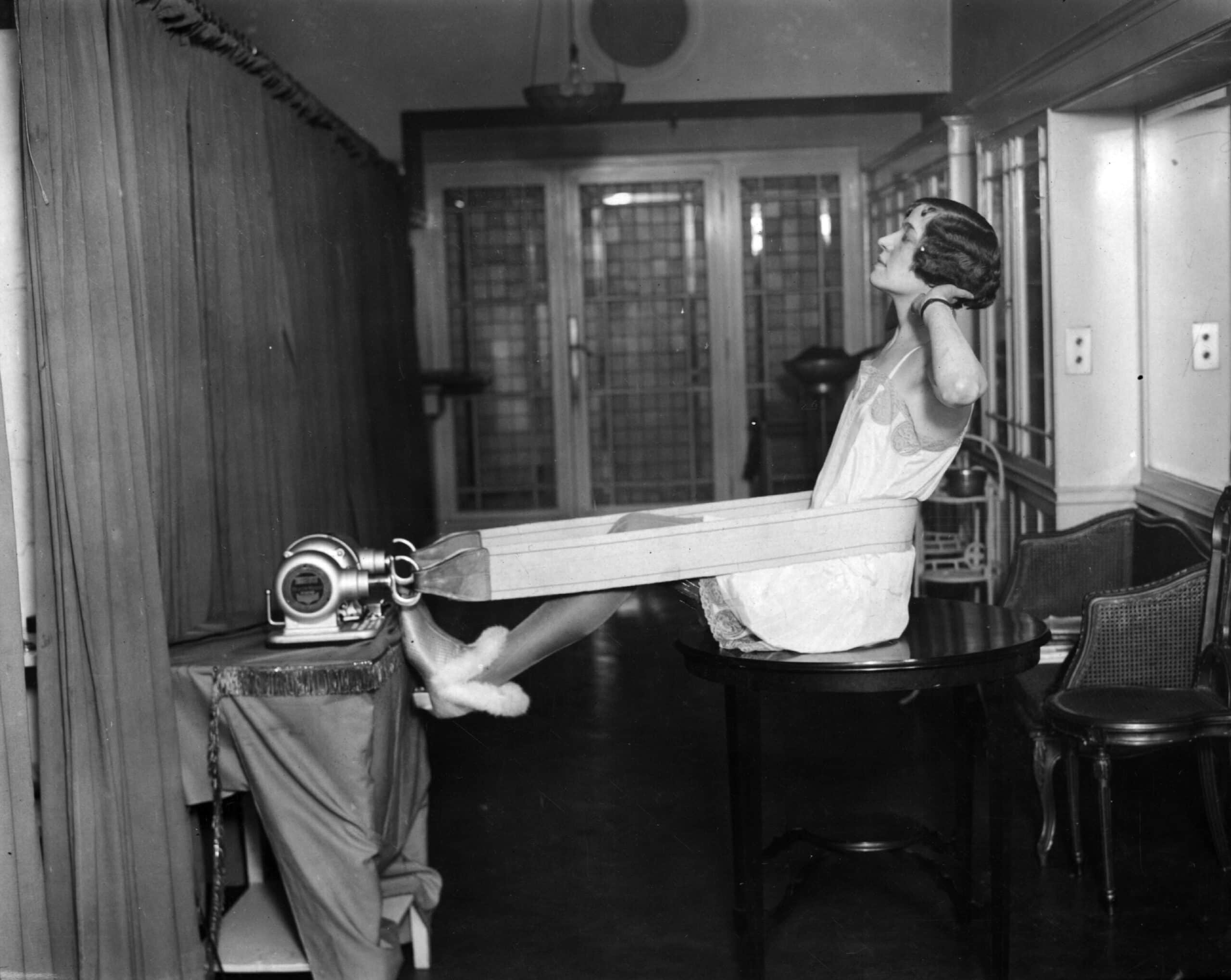
1928: A woman 'exercising' on a vibrating motor machine. (Photo by Davis/Topical Press Agency/Getty Images)
Back in 1928, this vibrating motor machine qualified as exercise. We think it’s worth noting, however, that the woman is seated on a table with her feet propped up, making this perhaps the most passive exercise known to humankind.
Gym Class
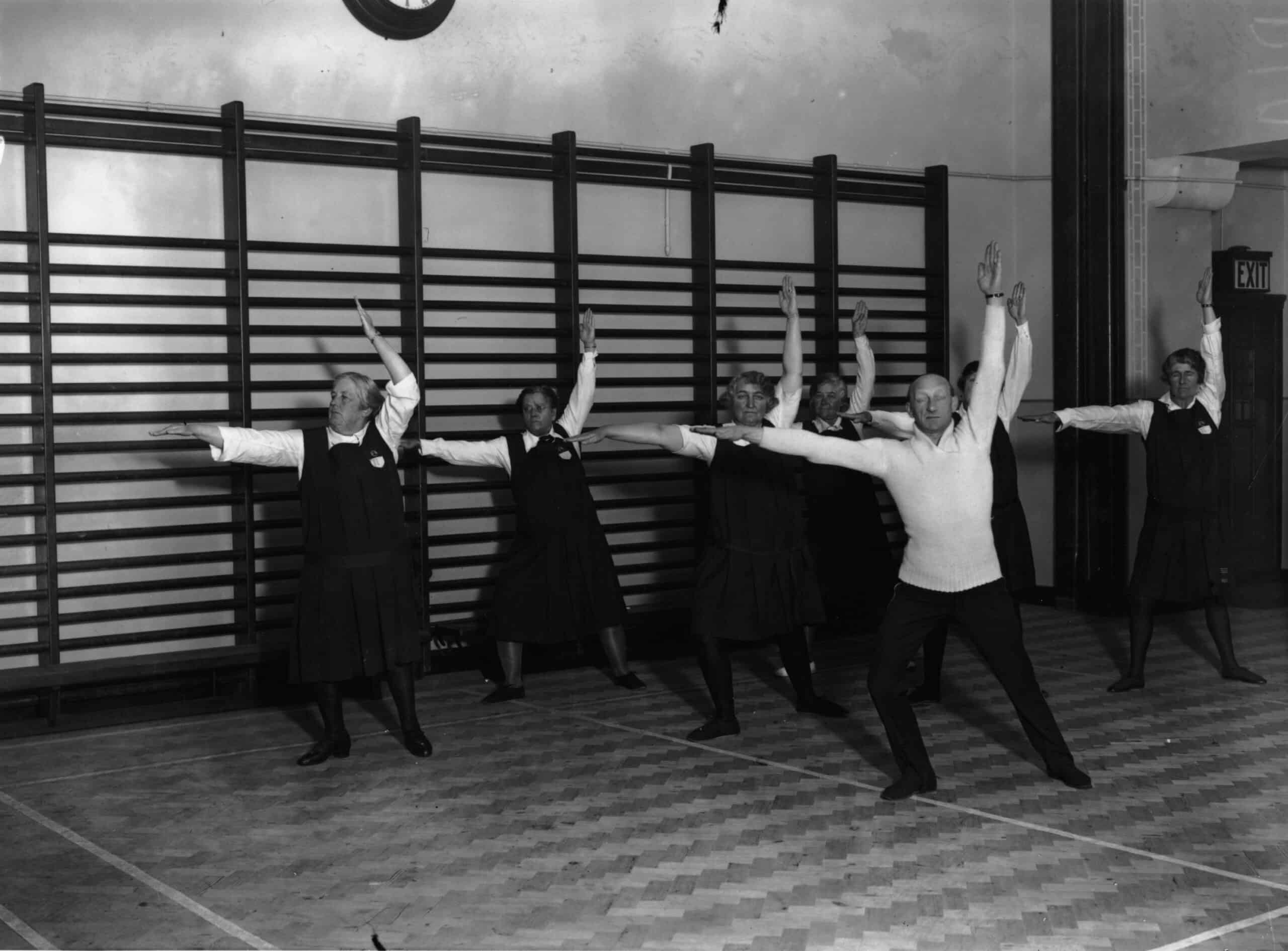
circa 1928: Energetic elderly women in action at a gym class. (Photo by Topical Press Agency/Getty Images)
Don’t discount the elderly when it comes to fitness in the early 20th century. Here, a group of senior ladies take part in gym class in 1928. Some wore shoes, some did not. All, though, wear faces of grit and determination, admirable qualities for which women are still known today.
Spring Shoes
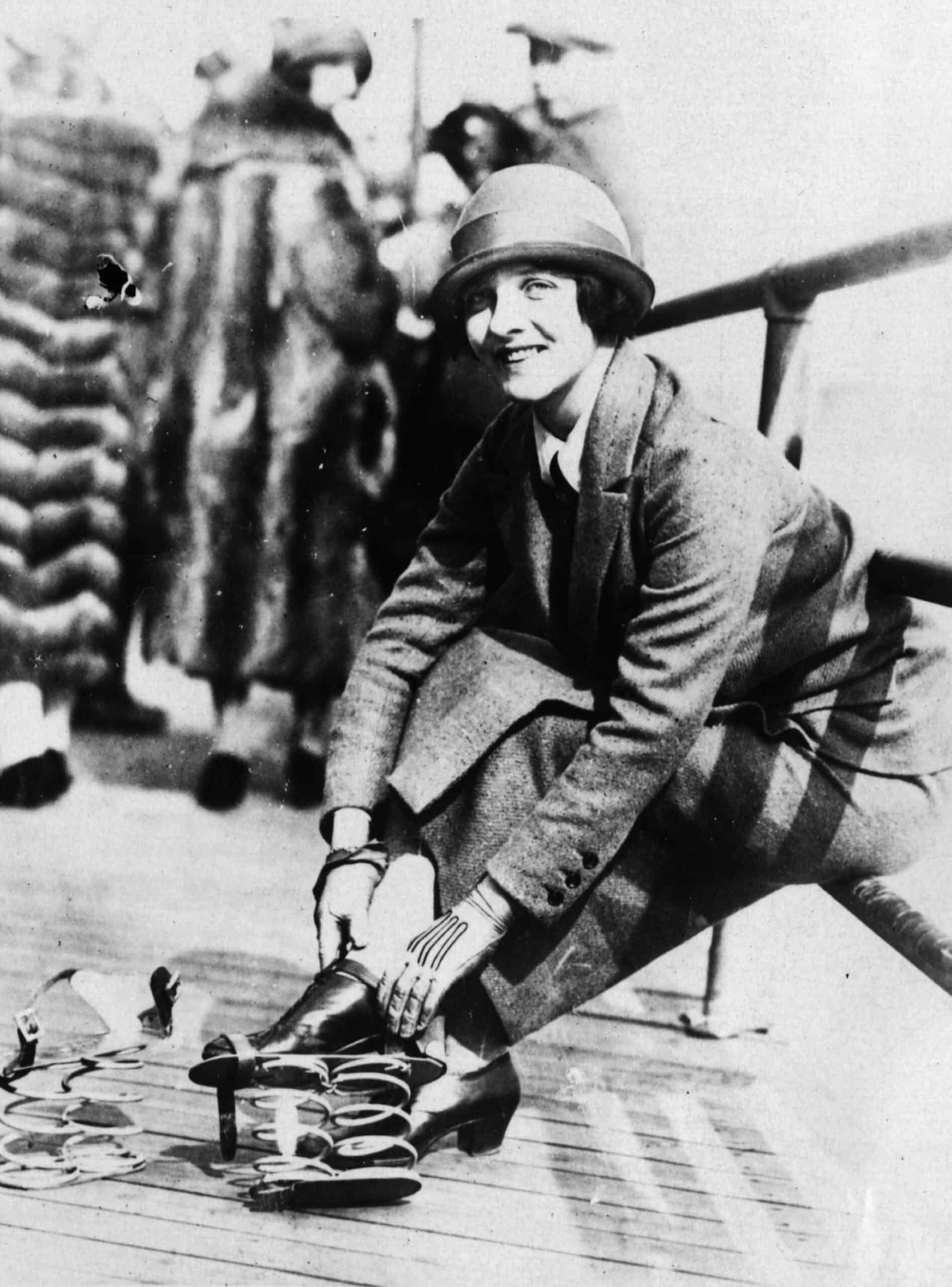
7th April 1925: A woman putting on a pair of shoes with springs attached to the soles, for exercising along the boardwalk in Atlantic City, New Jersey. (Photo by Topical Press Agency/Getty Images)
No, spring shoes never really took off as an exercise option, per se, but back in 1925, they were still a sight to behold. Strapping on a pair of springs, this gal went for a bounce along the Atlantic City boardwalk for her exercise.
Clubbing
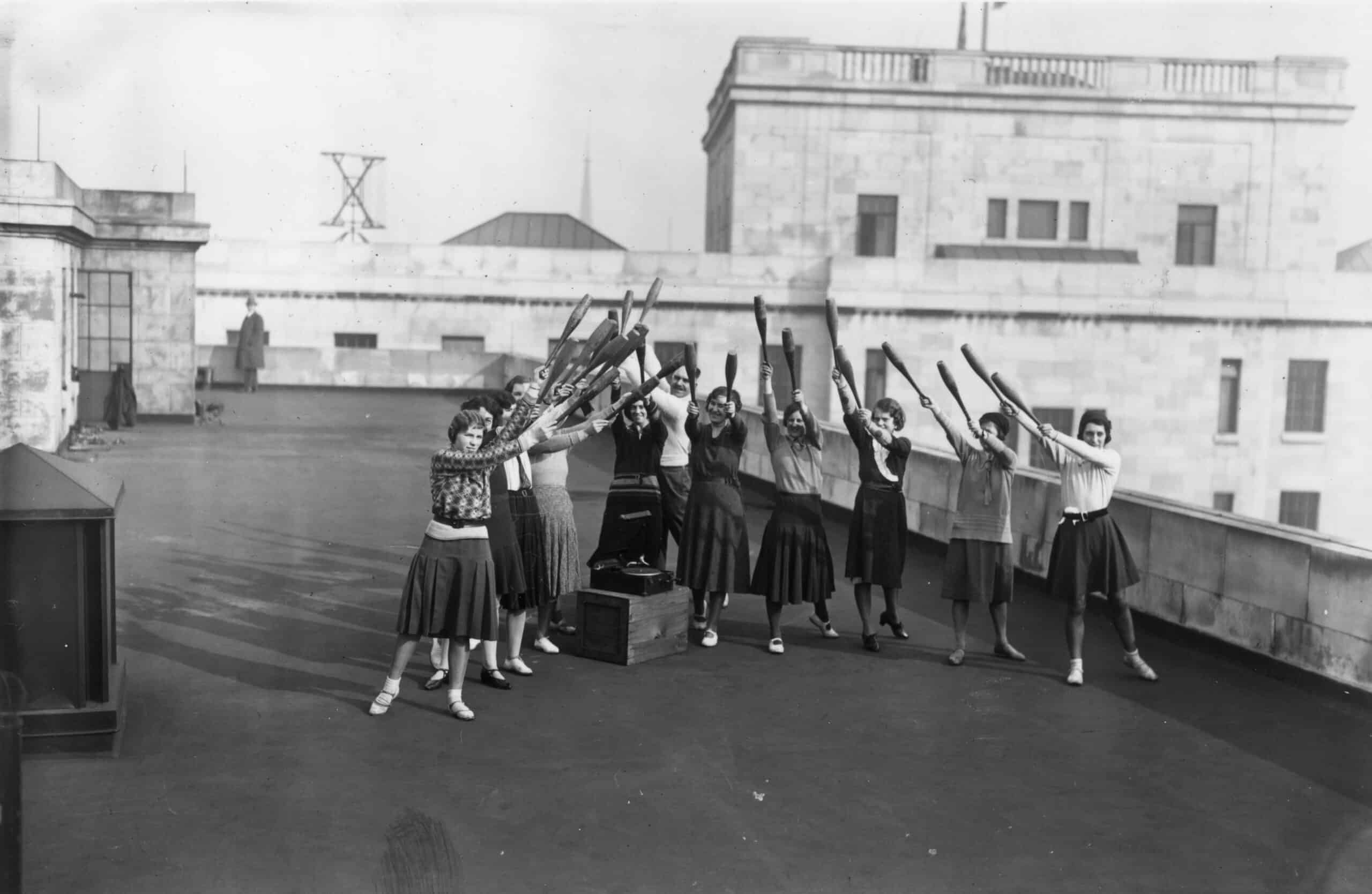
19th February 1932: Women club-swinging on the roof of Bush House, The Strand, London. (Photo by J. A. Hampton/Topical Press Agency/Getty Images)
Long before women swung kettlebells at BootCamp class, they swung clubs, known at the time as “Indian clubs,” or meels. The apparatus, shown here in 1932, was available in a variety of sizes and weights and was designed for strength training. Some fitness pros claim still today that these are a superior form of strength training to dumbbells.
Snow Skiing
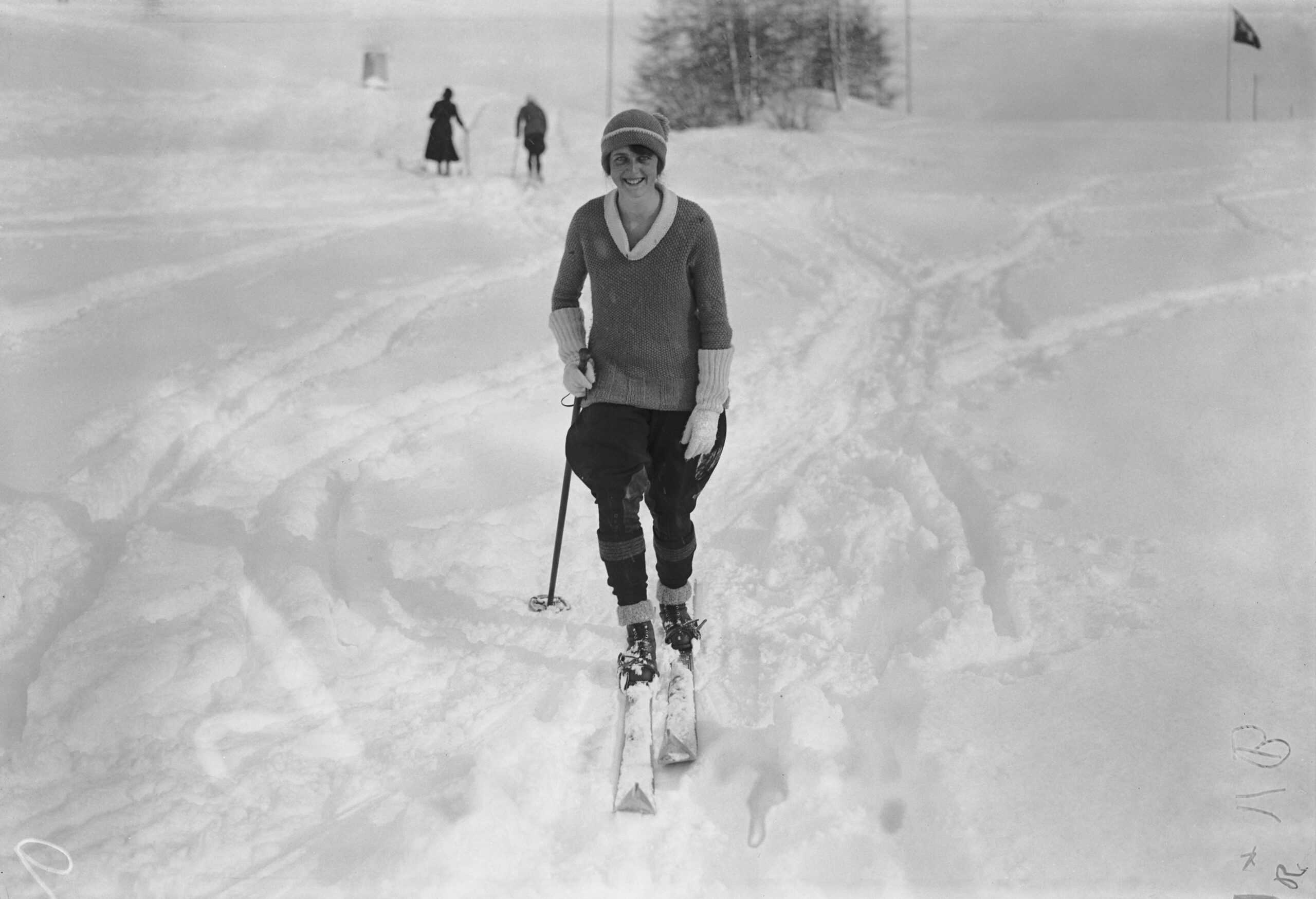
Mrs G. Doyle on the ski slopes at St Moritz, Switzerland, February 1921. (Photo by W. G. Phillips/Topical Press Agency/Hulton Archive/Getty Images)
Back in 1921, women typically worse skirts to snow ski. This gal, however, bucked the fashion system and opted for a more traditional male outfit of pants and a sweater. Note the skirt-wearing lady in the background, though.
High Jump
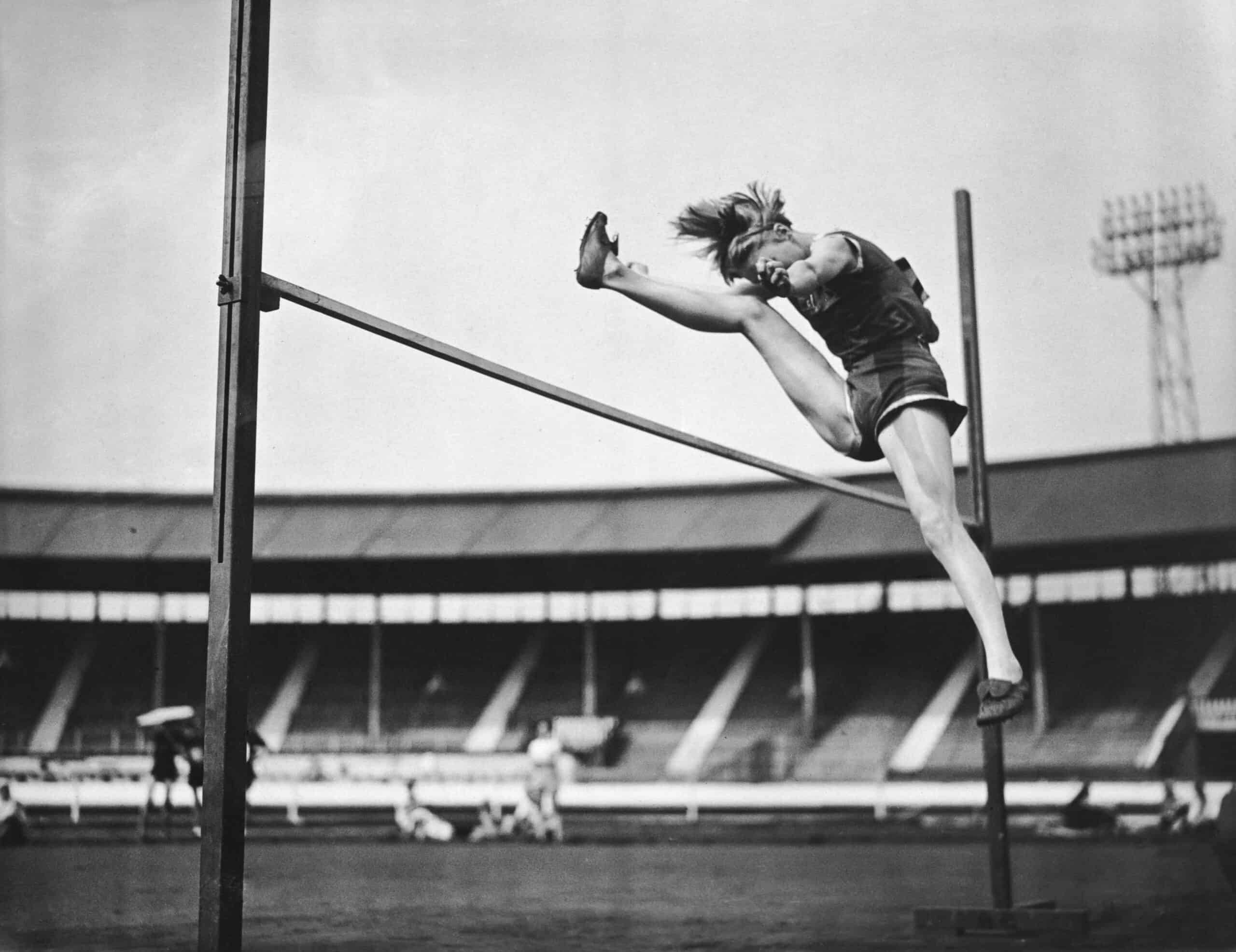
British athlete Dorothy Tyler-Odam competes in the high jump event during the Women's AAA Championship meeting at White City, London, 7th August 1937. (Photo by A. Hudson/Topical Press Agency/Getty Images)
Dorothy Tyler-Odam was a British high jumper. She’s shown here competing at the 1937 Women’s AAA Championship. A year earlier, she took the silver at the 1936 Olympic Games, and she won silver again in the 1948 Olympics, making her the only woman to win a medal both before and after WW2.
Car Racing
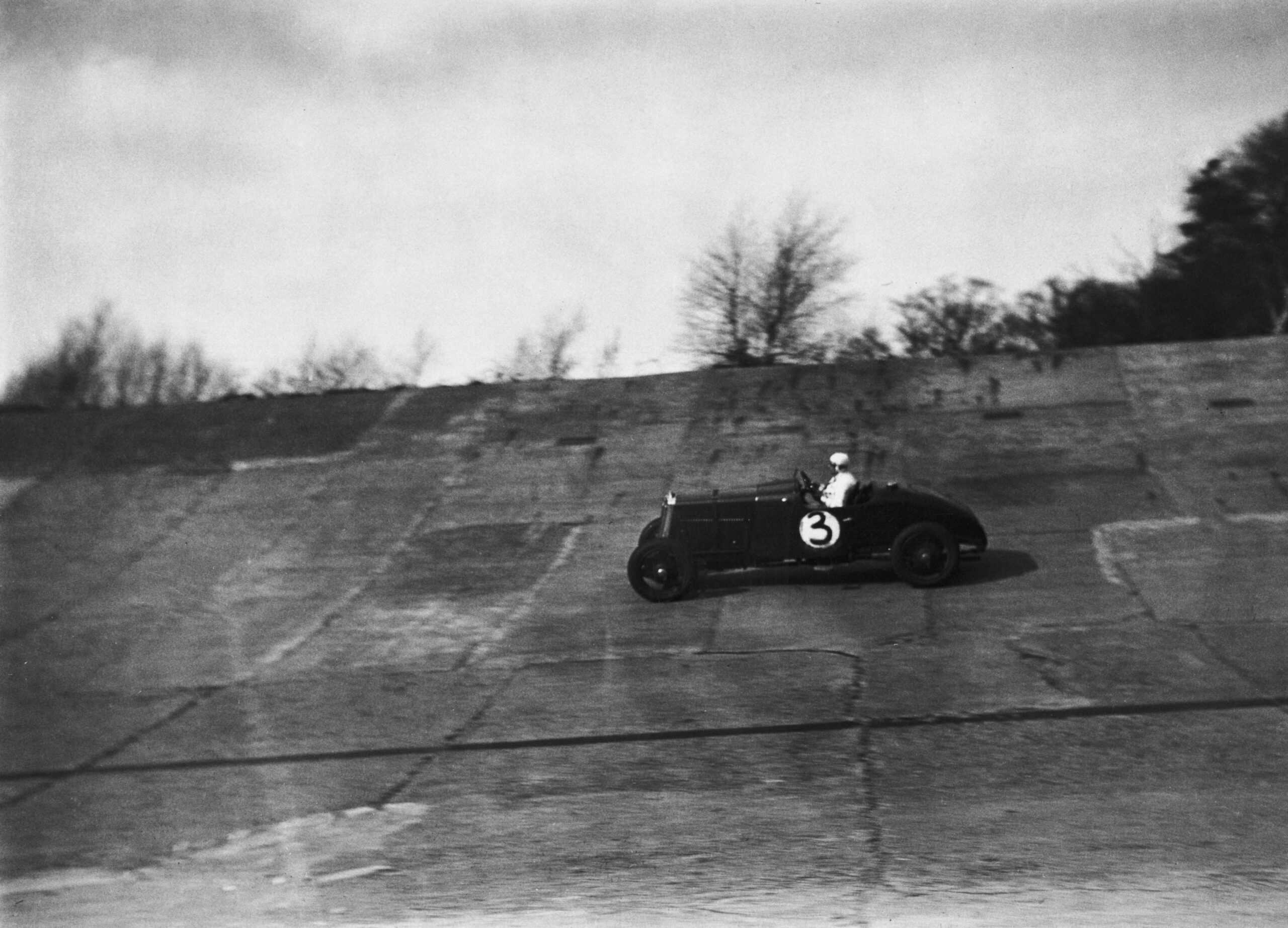
British racing driver Joan Chetwynd (1911 - 1974) competing in a Lea Francis racing car during a Ladies' Race at Brooklands, 22nd March 1930. (Photo by Douglas Miller/Topical Press Agency/Hulton Archive/Getty Images)
Nearly a century before Danica Patrick staked her claim in car racing history at 2008’s Firestone IndyCar 300 race, British racer Joan Chetwynd (known among fans as The Honourable Mrs. Chetwynd) carved out a space for women drivers. In fact, Chetwynd set a record in 1929, driving her Meadow-engined 1500cc Lea-Francis at an average speed of 82.98 mph. (For comparison’s sake, Danica Patrick clocked 229.88 mph at practice for the Indy 500.)
Billiards
Though not competing, the women shown here simply enjoyed a game of pool back in 1918 at their local women’s club. That’s not to say women didn’t compete in billiards back then. In fact, there have been professional women billiards players since back in the late 19th century.
Archery
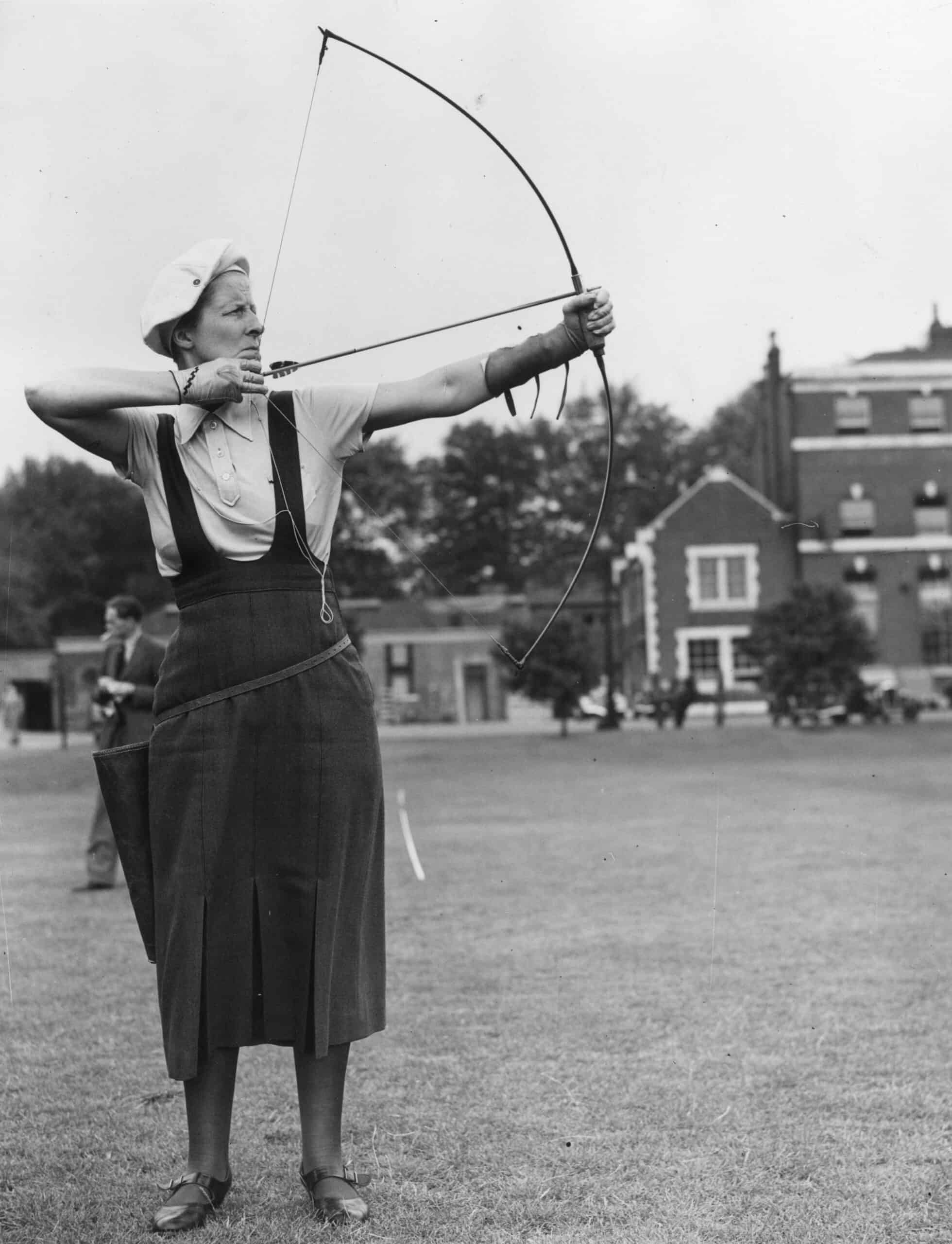
8th August 1938: Mdm Fahlman a member of the Swedish Ladies team competing in the 8th International Archery Tournament held at the Honourable Artillery Company's ground at Finsbury Square, London. (Photo by John F. Stephenson/Topical Press Agency/Getty Images)
Interestingly, archery is one of the earliest sports to allow women to not only play but also to compete. In fact, women’s archery was added as an event in the 1904 Olympic Games. Here, a female archer takes aim back in 1938.
Motorcycle Racing

22nd August 1925: Miss E Foley and Miss L Ball on their motorcycles at the International Six Days Reliability Trials at Brooklands race track. (Photo by Kirby/Topical Press Agency/Getty Images)
In 1925, these gals took to their cycles to compete at the International Six Days Reliability Trials. While that was no precursor to the X-Games, it IS the oldest off-road motorcycle race on the calendar of the Fédération Internationale de Motocyclisme, or FIM, which is the global governing body of motorcycle racing. Some records show women riding motorcycles in a non-competitive fashion as early as 1910.
Ice Dancing
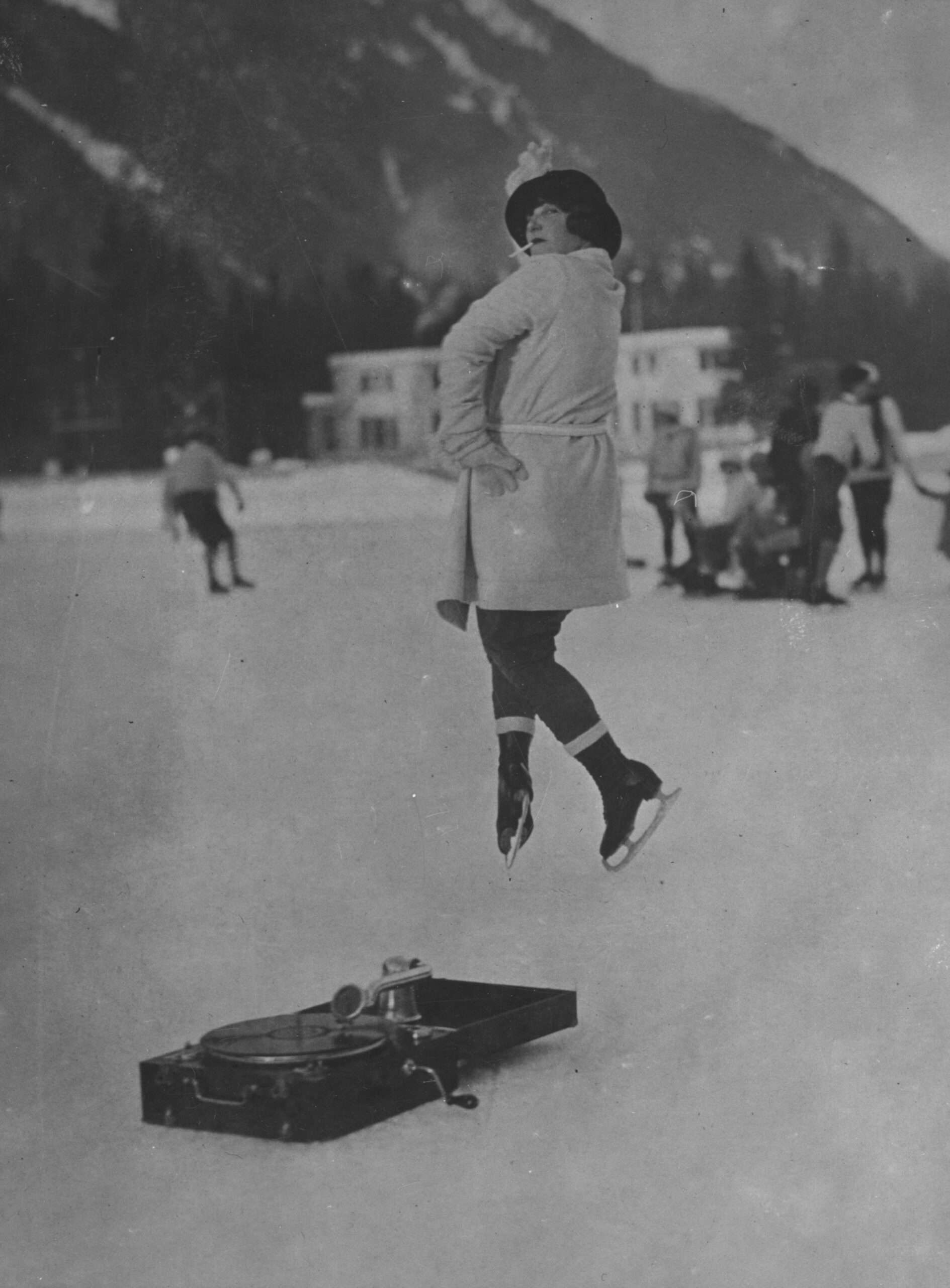
24th January 1924: A woman dancing to a gramophone in Chamonix, France. (Photo by Topical Press Agency/Getty Images)
And finally, this ice dancer shows us that back in 1924, as long as you had a gramophone and a smoke, you could lace up your skates and show off your moves — on ice or anywhere else for that matter.
